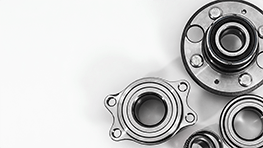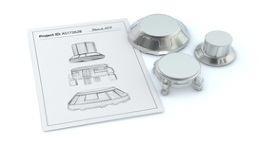Stainless Steel 304
304 is the most common stainless steel alloy and is known for its pristine surface finish. It has significantly higher corrosion and oxidation resistance than carbon steels. 304 is formable, weldable and ideal for use in corrosive environments. Typical applications include railroad and industrial equipment, transport containers, household appliances, and hand tools.
Stainless Steel 305
Has the highest formability of all austenitic stainless steels making it ideal for applications such as barrels and shells. 305 is best suited for cold working processes such as drawing, spinning and blanking, although it can be hot worked by forging and heading. It’s not heat treatable, but can be welded. 305 is used in products including drawn housings, rivets, tank covers, and writing instruments.
Stainless Steel 309
Ideal for high-temperature applications up to 1900°F. It is stronger than 304 and has higher corrosion resistance. 309 can be cold worked but is not heat treatable. It is weldable and relatively easy to machine. This alloy is often used in furnaces, thermowells, power boiler tube hangers, generators, paper mills, petroleum refining, brazing fixtures, anchor bolts and refractory supports.
Stainless Steel 310
Maintains its strength and corrosion resistance up to 2100°F and can also be used at cryogenic temperatures reaching as low as -450°F. It has superior corrosion resistance compared to 309, can be welded and cold worked, but cannot be heat treated. Common applications include oil burners, heat exchangers, combustion tubes and chambers, radiant tubes, kilns, and conveyor belt rollers.
Stainless Steel 314
Nearly identical to 310 but contains more silicon to provide increased heat resistance. Common applications include furnaces, oil burners, heat exchangers, combustion tubes and chambers, firebox sheets, flare tips, welding rods, filler wires, annealing covers, fluidized bed coal combustors, radiant tubes, tube hangers, coal gasifier components, and kilns.
Stainless Steel 317
Often used in highly corrosive environments. This alloy is weldable, easily machined, and can be cold and hot worked, but it cannot be heat treated. 317 is ideal for making generators, absorber towers, boilers, condenser tubes, heat exchangers, pipes, pressure vessels, stack liners, fittings, and valves.
Stainless Steel 321
Ideal for use in temperatures reaching up to 1500°F. It is minimally prone to creep and rupture, and highly resistant to scaling and vibration fatigue. 321 is often used to make aircraft exhaust stacks and manifolds, jet engine parts, boiler shells, cabin heaters, pressure vessels, flexible coupling, expansion joints, and wire cloth.
Stainless Steel 347
Nearly identical to 321 but offers higher resistance to intergranular corrosion. 347 is often used to make aircraft exhaust stacks and manifolds, jet engine parts, chemical processing equipment, boiler shells, cabin heaters, pressure vessels, flexible coupling, expansion joints, and wire cloth.
Stainless Steel 348
Nearly identical to 347 but contains more cobalt. 348 is often used to make aircraft exhaust stacks and manifolds, jet engine parts, chemical processing equipment, boiler shells, cabin heaters, pressure vessels, flexible coupling, expansion joints, and wire cloth.
Stainless Steel 405
Ideal for welding applications. It is highly formable and easily machined. Typical applications include annealing boxes, steam nozzles, quenching racks, partitions and parts that can’t be annealed after welding.
Stainless Steel 409
Maintains excellent corrosion resistance at high temperatures. This alloy is weldable, easily machined, and can be cold and hot worked, but cannot be heat treated. 409 is ideal for agricultural spreaders, exhaust pipes, catalytic converters, mufflers, automotive thermostats, structural support and hangers, and shipping containers.
Stainless Steel 410
Contains a minimum of 11.5% chromium, making it exceptionally resistant to corrosion from many chemicals and acids. This alloy is weldable, easily machined, heat treatable and can be cold and hot worked. Applications include nuts and bolts, press plates, valves, surgical instruments, and petroleum refining equipment.
Stainless Steel 414
Nearly identical to 410 but contains nickel which increases corrosion resistance. Applications include bolts and nuts, press plates, valve components, surgical instruments, and petroleum refining equipment.
Stainless Steel 430
Highly formable and has exceptional resistance to acids and stress corrosion cracking. This alloy is often used in home appliances, fasteners, and automotive trim.
Stainless Steel 431
Has the highest corrosion resistance of all hardenable martensitic stainless steels. It can be hot or cold worked, and hardened up to 40 HRC. Typical applications include valves, pumps, aircraft components, propeller shafts, and marine equipment.
Stainless Steel 434
Nearly identical to 430 but contains more molybdenum which provides better heat and corrosion resistance. It is formable, weldable and easily machined. 434 is ideal for automotive trim and molding, furnace combustion chambers, gas burners, dishwashers, range hoods, steam iron bases, flatware, and gutters.
Stainless Steel 436
Nearly identical to 434 but contains more molybdenum and titanium which allows for higher pitting corrosion resistance. 436 is used for furnace combustion chambers, gas burners, dishwashers, range hoods, steam iron bases, flatware, and gutters.
Stainless Steel 442
Has exceptionally high corrosion resistance due to high levels of chromium. It has excellent heat resistance but cannot be heat treated and is difficult to machine. Applications include furnace and combustion components, zinc die casting machines, nitrogen fixation parts, storage tanks for nitric acid, and decorative trim.
Stainless Steel 446
Ideal for high-temperature applications due to excellent resistance to hot corrosion and oxidation. It is weldable, easily machined, but cannot be heat treated and is difficult to cold work. Applications include boiler baffles, thermocouple protectors, neutral salt pot electrodes, waste heat boilers, X-ray tube bases, oil burners, and incinerators.
Stainless Steel UNS S31803
Has excellent corrosion resistance but is not suitable for temperatures exceeding 500°F. This alloy is weldable, easily machined, and can be both cold formed and hot formed. S31803 is the most common duplex steel. Typical applications include pumps, valves, chokes, flanges, bolts, connectors, manifolds, generators, augers, fasteners, instrumentation tubes, press rolls, and screw conveyors.
Stainless Steel UNS S32003
This nitrogen enhanced duplex steel is known for high strength. This alloy is easily formed and machined. UNS S32003 is often used in subsea oil and gas fields.
Stainless Steel UNS S32101
This duplex stainless steel is stronger than 304 and and has better corrosion resistance. Typical applications include biodiesel plants and tanks, chemical process, bridges, flood gates, white liquor storage tanks, washers, desalination system chambers, and wastewater treatment plants.
Stainless Steel UNS S32304
Nearly identical to 304 and 316 but offers much higher high yield strength. This alloy is weldable, easily machined, and can be both cold and hot worked. UNS S32304 is ideal for use in storage tanks and pressure vessels.
Stainless Steel UNS S32205
Nearly identical to UNS S31803 but has more nitrogen to increase corrosion resistance. Typical applications include pumps, valves, chokes, pipeworks, flanges, bolting, connectors, manifolds, oil and gas industry equipment, power generators, cargo tanks, couplings, fasteners, instrumentation tubes, press rolls, and screw conveyors.
Stainless Steel UNS S32760
This super duplex steel is weldable and easily machined. UNS S32760 has significantly higher strength and corrosion resistance than UNS S32205. Typical applications include marine equipment, mining tools, and pharmaceutical products.
Stainless Steel UNS S32550
This super duplex steel is known for high corrosion resistance and impressive strength. Typical applications include valve bodies, marine equipment, pumps, and shafts.
Stainless Steel UNS S32707
This hyper duplex steel is weldable and is often used in high-chloride environments. UNS S32707 has higher corrosion resistance and higher strength than UNS S32750. Typical applications include marine equipment, petroleum equipment, and heat exchangers.
Stainless Steel UNS S33207
This hyper duplex steel is known for excellent resistance to stress corrosion cracking and exceptionally high mechanical strength. UNS S33207 is often used to make oil and gas exploration equipment.





